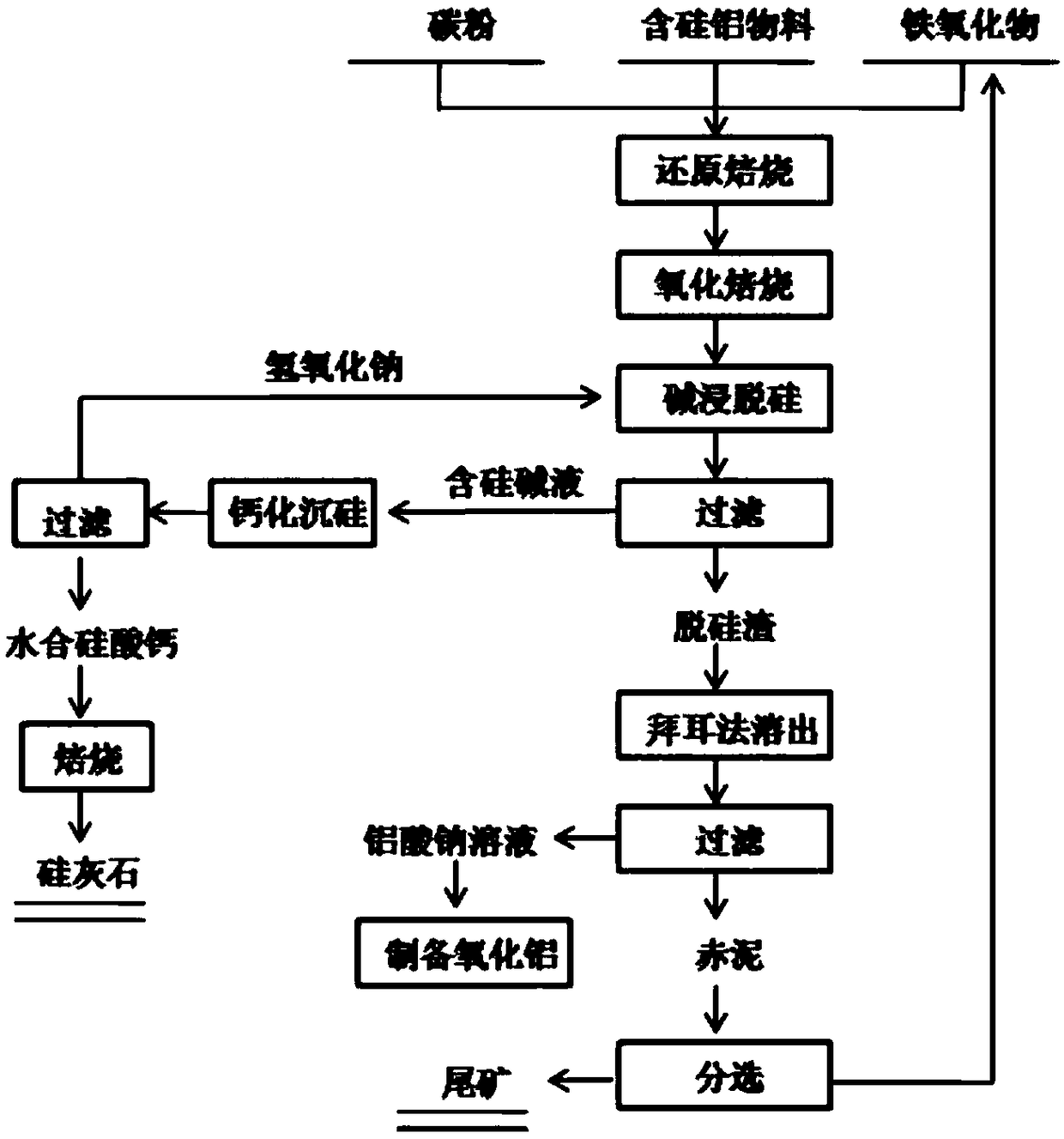Method for desiliconizing silicon and aluminum containing material
A material, silicon-aluminum technology, which is applied in the field of desiliconization of silicon-aluminum materials, can solve the problems of low silicon oxide dissolution rate and difficult desiliconization of high-silicon and aluminum-containing minerals, so as to increase the added value of products, improve the purity, and improve the economy. Significant effect
- Summary
- Abstract
- Description
- Claims
- Application Information
AI Technical Summary
Problems solved by technology
Method used
Image
Examples
Embodiment 1
[0037] The molar ratio of iron oxide: alumina in kaolin: carbon = 1.1:2:1.1 is used for batching, and after roasting in a reducing atmosphere at 1100°C for 60 minutes, it is oxidized and roasted at 900°C for 30 minutes; the obtained roasted clinker is finely ground to less than 74μm , use sodium hydroxide solution to desilicate roasted clinker by alkali leaching, the leaching temperature is 110°C, the liquid-solid ratio is 5, the concentration of sodium hydroxide solution is 160g / L, and the leaching time is 120min. Under these conditions, the silicon oxide The dissolution rate was 90.5%.
[0038] Add digested calcium oxide to the silicon-containing alkali solution obtained by desiliconization according to the ratio of calcium-silicon molecular ratio of 1:1, hydrothermally react at 110°C for 5 hours, the silicon precipitation rate reaches 95.7%, and the sodium hydroxide obtained by separation The solution can be returned to the alkali leaching desiliconization process to contin...
Embodiment 2
[0041] The molar ratio of iron oxide: alumina in kaolin: carbon = 1.1:2:1.1 is used for batching, and after roasting in a reducing atmosphere at 1050°C for 60 minutes, it is oxidized and roasted at 950°C for 30 minutes; the obtained roasted clinker is finely ground to less than 74μm , use sodium hydroxide solution to desilicate roasted clinker by alkali leaching, the leaching temperature is 110°C, the liquid-solid ratio is 5, the concentration of sodium hydroxide solution is 160g / L, and the leaching time is 120min. Under these conditions, the silicon oxide The dissolution rate was 90.1%.
[0042] Add digested calcium oxide to the silicon-containing alkali solution obtained by desiliconization according to the ratio of calcium to silicon molecular ratio of 1:1, and react hydrothermally at 110°C for 5 hours, the silicon precipitation rate reaches 95.02%, and the sodium hydroxide obtained by separation The solution can be returned to the alkali leaching desiliconization process t...
Embodiment 3
[0045] The molar ratio of iron oxide: alumina in kaolin: carbon = 1.2:2:1.2 is used for batching, and after roasting in a reducing atmosphere at 1100°C for 60 minutes, it is oxidized and roasted at 1000°C for 30 minutes; the obtained roasted clinker is finely ground to less than 74μm , using sodium hydroxide solution to desilicate roasted clinker by alkali leaching, the leaching temperature is 110°C, the liquid-solid ratio is 3, the concentration of sodium hydroxide solution is 200g / L, and the leaching time is 120min. Under these conditions, the silicon oxide The dissolution rate was 89.87%.
[0046] Add digested calcium oxide to the silicon-containing alkali solution obtained by desiliconization according to the ratio of calcium to silicon molecular ratio of 1:1, hydrothermal reaction at 110°C for 5 hours, the silicon precipitation rate reaches 95.01%, and the sodium hydroxide obtained by separation The solution can be returned to the alkali leaching desiliconization process ...
PUM
| Property | Measurement | Unit |
|---|---|---|
| Average particle size | aaaaa | aaaaa |
| Average particle size | aaaaa | aaaaa |
| Average particle size | aaaaa | aaaaa |
Abstract
Description
Claims
Application Information
 Login to View More
Login to View More - R&D Engineer
- R&D Manager
- IP Professional
- Industry Leading Data Capabilities
- Powerful AI technology
- Patent DNA Extraction
Browse by: Latest US Patents, China's latest patents, Technical Efficacy Thesaurus, Application Domain, Technology Topic, Popular Technical Reports.
© 2024 PatSnap. All rights reserved.Legal|Privacy policy|Modern Slavery Act Transparency Statement|Sitemap|About US| Contact US: help@patsnap.com









